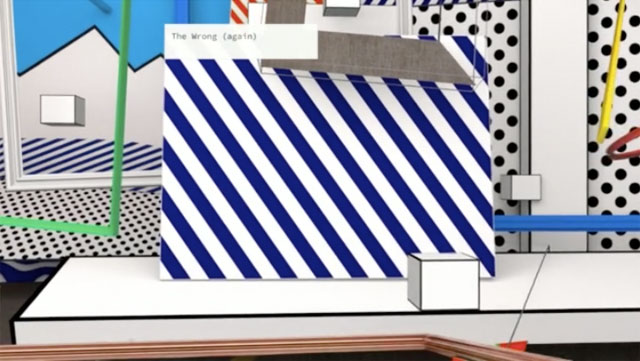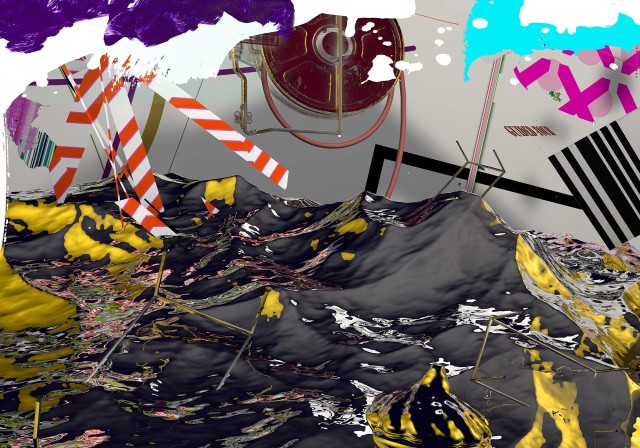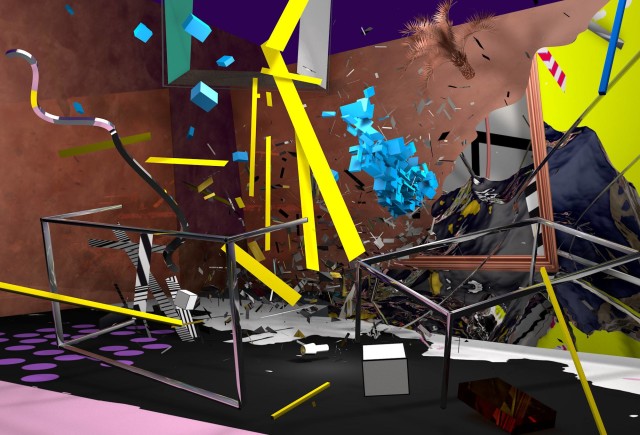
Official imagery for “The Wrong (again)”, made by Stefan Saalfeld
This Sunday, the new digital art biennale known as “The Wrong” (again) will officially go online. When the biennial first launched in 2013 it brought together the work of 30 curators and over 300 participants. Curators organized standalone websites that were linked to from the Wrong’s main page. It was massive. This year, the event will be an overwhelming three times larger with over 90 curators, 900 participants and 40 brick and mortar locations referred to as “Embassies”. A quick look at the press release shows such curators such as artist Patrick Lichty, Alfredo Salazar-Caro and AFC’s own Rea McNamara on the roster (a full list of participants at the bottom of this post) and embassies from spaces flung across the world; Lampa Studio – St. Petersburg, Bilbao Arte – Bilbao, Espacio Pla – Buenos Aires. And of course plenty of American locations as well; Brooklyn’s Transfer Gallery tops the list. The biennial runs from November 1st through January 31st (though some embassies will launch in advance of the official launch date).
It’s hard to understate how impressive the scale of this undertaking is, given the budget it runs on. Wrong founder and organizer David Quiles Guillo has some help from Cargo to provide server space, but funds the rest of the biennale out of pocket. (Support the biennale on Indiegogo.) The fact that an event this size this can even exist on a small budget is slightly mind-boggling.
I’m not sure how we’re going to see it all, but in preparation for the day, I spoke to the Wrong founder and organizer David Quiles Guillo. I wanted to get a sense of how the biennial came to be in the first place and what we can expect this time around. Quiles Guillo promises less chaos, but a fairly open curator selection process. Come Sunday, we’ll see what all this democracy brings. My conversation with him below.

Official imagery for “The Wrong (again)”, made by Stefan Saalfeld
How did you start the Wrong Biennial and why?
I first had the idea for the Wrong in 2003 but the networks weren’t fast enough and everything was in Flash. The whole idea was to create a platform for artists to show their work. In the meantime, I created ROJO and festivals like NOVA.. But with these physical events, most of the money went to visas, flights and hotels and not into artist pockets. So, I was frustrated with that.
And soon, I was burned out. Having this real life thing and working with the artists for 6 weeks while they complained about things like nails was too much.
So, I started to wonder if I could put all the energy I put into NOVA into the digital biennial. So we reached out to friends. And those friends reached out other friends. By the time [the first one] launched [in 2013], we were connected to so many artists that social media became a very effective way to get the word out. It made the Wrong popular.
So, launching a second edition was natural?
In the second edition I wasn’t sure if we were even going to make it happen. I thought maybe we had already featured everyone who is worth featuring. But some of the past participants pushed me to do it and I started working on it early last year.
Now we are in the stressing part—getting everyone online. This time around, we have 90 curators. We have 50 pavilions [curated stand alone websites linked to by the Wrong], but I believe there will be 60 by Sunday. In 2013 there were 13 embassies [brick and mortar biennial participants who host physical events and shows.] Now there are 40. Bejing, Siberia, Montreal, San Francisco, Italy, New York. We’re in some unexpected locations too. We’re building a show in a remote city in Romania which is an amazing addition!

Official imagery for “The Wrong (again)”, made by Stefan Saalfeld
What can we expect?
I haven’t seen all the content, and unfortunately I can’t name highlights. But this one is going to be 3 times larger than the last Wrong Biennial. It’s a three month long event, so you can literally spend 10 minutes a day on one pavilion and it will take two months to view. But there are also all the events we are going to present—over 200 acts—[the combined name for] pavilions, events, embassies, and streamed events. One of the pavilions in Buenos Aires will host 70 events in 90 days! It’s overwhelming like the Internet.
What are the benefits of making a biennale this size?
It’s not our objective to make it big. It’s just how it is. The navigation is really fast.
For the first Wrong, I had to work hard to find people to help me build it. This one, I just opened the doors. We’re going to find a lot of variety….there are a lot of beginners mixed with very experienced artists. What I like is that they are all together in the same place. I don’t want to do a biennale for elites. It’s a lot of levels and this is what I think a good art event should be. And it’s access free.
Wait, is there no curation of who gets a pavilion? Or some curation? Who is doing the curating?
I’m the one selecting the people for pavilions. So before I say yes, I do my research. I make sure it’s not just a prankster. But even if he was a prankster, we might include him. What’s really nice about organizing the online event you have flexibility. You can accept people at the last minute. It’s a gathering event.
Since there’s such a diverse range of pavilions and artists, how will people be able to find the work they like?
The first Wrong was messy but this time we’ve solved a lot of problems. It’s a major jump. The whole site is built on tags. It tells you who’s creating what. Then we have this tool, World Wide Tours, we built with Arebyte’s Nimrod Vardi. Every week we’re going to create content and this website is going to take you to highlights.
Will also have a text based pavilion for theory and ongoing reviews and we have some tools that are really making your experience a little bit easier.
Did you get any funding for the project this year?
No funding. We have a donate button on the website. But I also have my own my piggy bank that I will share with artists and curators this time. So I hope we can raise some money. My objective with the Wrong is to get a sponsor. I’ve done it before with NOVA.
After the first event I paid cash to creators but I could only pay half because I didn’t get the funding. The financials for this one is taking a little bit longer than I expected. But I have a ten year plan and am going to try to do five biennials.
And hopefully the grants will come. I don’t know many events that gather so many artists and events under one roof with our budget. The energy and spirit of the Wrong is something we need to count on it. I think it’s what makes this event so special.
PARTICIPATING CURATORS
Frère Reinert & Ellectra Radikal, Robert Seidel, Alfredo Salazar-Caro, Valentina Fois, Benoit Mathieu Palop, Jan Robert Leegte, Mathieu St-Pierre, Clif Pottberg, Zoe Stawska, Hendrix Nash, Spencer Selby, Rob Mac, Troy Ford, Rea McNamara, Morehshin Allahyari, Haydi Roket, Ciro Museres, Elena Garnelo, Anthi Tzakou, Andreu Belsunces, Nicolás Gerardi, Mario Santamaria, Cesar Escudero Andaluz, Seyhan Musaoglu, Liaizon Wakest & Nıhıl Mınus, Marios Athanasiou, Koen Delaere, Just Quist, Nimrod Vardi, Tine Scharffenberg, Lucie Kåss, Ann-Kristin Olsen, Kamilia Kard, Filippo Lorenzin, Johann Velit, Emilia De Las Carreras, Celina Pla, Merlina Rañi, Virginia del Río, Glenn Young, Shaina Why, Sarah Wang, Pashalia Kazantzidou, Enrique Salmoiraghi, Gerhardt Rubio Swaneck, Vedran Gligo, Tyler Kline, James Bowen, Joseph Flynn, Gibrann Morgado, Valeria Hernández, Adrienne Crossman, Amy Smith, Unmaru Un, Soo Hye Baik, Victoria Vinamaragui, León de la Rosa, Gabriel Menotti, Adhi Suryo, Maria Balea, Dina Karadžić, Serj Kirchano, Cruz Garcia, Nathalie Frankowski, Agustin Genoud, Evgenia Zalivina, Tom Milnes, Annalisa Trapani, Janire Goikoetxea, Jon Hannis, Erik H Zepka, Erica Lapadat-Janzen, Shauna Jean Doherty, Jon Hannis, Stephanie Mendosa David Musgravem, Timothy Furstnau, Alix Desaubliaux & Hugo Lermechin, Patrick Lichty, Julia Borges Araña, Guilherme Brandão, David Quiles Guilló.
PARTICIPATING EMBASSIES
Transfer (Brooklyn), University of the Art (Philadelphia), UMASS Student Union Gallery (Amherst), Nootropic Automat (New Orleans), PDX Hackerspace (Portland), Noisebridge (San Francisco), Great Wall of Oakland (Oakland), Xpace Cultural Centre (Toronto), Vivo Media Arts Centre (Vancouver), Bilbao Arte (Bilbao), Hangar (Barcelona), Plutón CC (Valencia), La Térmica (Málaga), Arebyte Gallery (London), Galerie Charlot (Paris), Ateliers Quatrepourcent (Nancy), Scatolabianca (Milan), WOWA (Rimini), Digital3mpire (Düsseldorf), Interface Cultures LAB (Linz), D’une Certaine Gaieté (Liege), Hacklab01 (Zagreb), Inquiry Inc (Osijek), Lampa Studio (St. Petersburg), ETAJ (Novossibirsk), Station (Beirut), Superliquidato (Cluj-Napoca), Space Debris (Istanbul), AUS College of Art and Design (Sharjah), El Museo Universitario del Chopo (Mexico DF), LaGun (Ciudad Juarez), Mirante (São Paulo), Federal University of Espírito Santo (Vitória), NNM Studio (Lima), Espacio Pla (Buenos Aires), Universidad Nacional de las Artes (Buenos Aires), Taller Monstruo (Santiago), Intelligentsia Gallery (Beijing), OMNI space (Bandung), Our Monster (Seoul), Fort Delta (Melbourne)


Comments on this entry are closed.
{ 2 trackbacks }